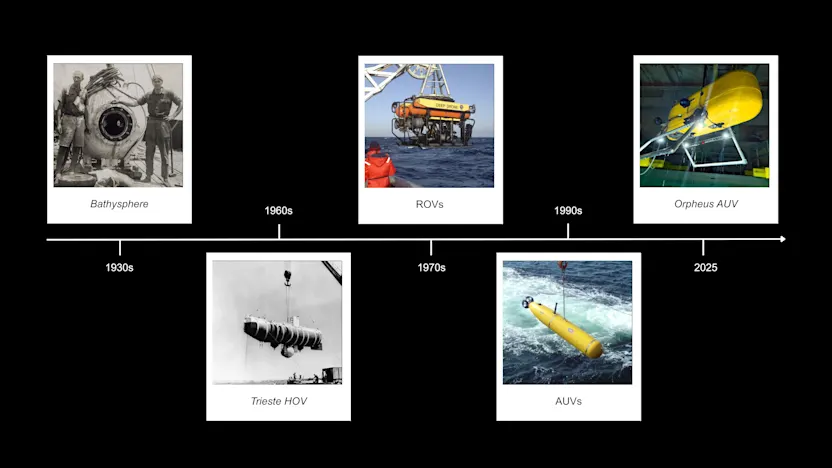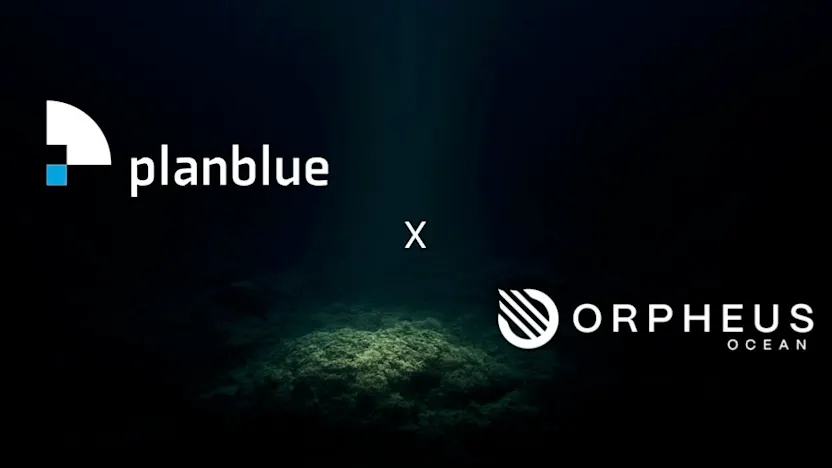
April 23, 2025
Testing, Tank and Field
One of the key priorities we set upon moving the Orpheus program away from its academic origins was to increase our “design → build → test” iteration rate. No matter how theoretically sound the design is, there are limits to the bugs you can shake out in a lab setting, and most engineers would agree it is better to find those sooner rather than later. To that end, as soon as primary construction of the first vehicle was finished, we pushed to get it in the water (any water) ASAP.
Yet another hidden benefit of being an ocean tech company in New Bedford is the test tank facility at UMass Dartmouth School for Marine Science & Technology (SMAST). Located only a short 10-minute drive from our HQ, the tank is designed for acoustic research (none of the walls are parallel, to minimize reflections). For us, however, it is enough to simply be a large swimming pool with a gantry crane above it.
The Baptism of Orpheus. Is that anachronistic?
Getting in the tank early was helpful for development in a number of ways. First, it gave us a deadline and forced us to fully assemble the vehicle into a working state, whether or not everyone feels ready. This alone was enough to generate loads of learning for the team, both in operations (i.e., how to open and close the sphere safely, how to wrangle the vehicle onto and off of a pickup truck) and design (move the magnetometer away from the high current wires). Second, it provides a chance for running the full system in a pseudo-real world environment that is just not possible in the lab. Verifying heading control, checking the altimeter, tuning the thrusters - all become much easier when immersed in the pool, generating a laundry list of issues to revisit when back in the workshop.



Plus it leads to some really atmospheric pictures.
For a robot meant to explore the deepest depths of the ocean, however, there is only so much that can be learned in a 20 ft tank. After regrouping back in the lab, we were ready to move on to open-water field testing in Buzzards Bay. We worked with Marine Imaging Technologies, a local business on Cape Cod that performs ROV videography services and also owns the 35’ catamaran MV Catapult (see below). The Catapult comes equipped with a work deck, an 800 lb winch, and a USBL tracking system, and is a good example of the extreme lower limit on size of vessel that could launch and retrieve the Orpheus AUV. For our testing purposes in shallow water, it is ideal.
The trusty MV Catapult (Credit: Marine Imaging Technologies)
Our plan for open-water testing was two-fold: 1) to validate and debug the sub-systems that we were not able to fully in the tank, such as navigation and imagery, and 2) to perfect a sample “mission” that replicates one we would typically perform for a customer. These goals were achieved with flying colors: over the course of a week, we progressed from dangling the vehicle in the water on a line, to successfully deploying it on 9 untethered missions to a maximum depth of 40 ft, covering several km of Buzzards Bay seabed. Luckily the weather also held up, with only a slight chill breeze on some days, and the ops crew of Francesca, Ishani, Ethan, and Casey officially earned their Orpheus Ocean sealegs.
Orpheus ponders the horizon, while the crew keeps her on a short leash.
Finally, the real reason we do all of this - data!! We were excited to generate our first benthic video footage from the Orpheus AUV, a sneak preview of which you can see below. Even without having dialed in the optimal lighting, altitude, and speed over ground, we are already seeing some pretty cool sights in the depths of Buzzards Bay, including a crab, an antique lobster pot, and many many jellyfish. Next stop, 5,000 meters…



The unexplored depths of the Southern Massachusetts coast hold many secrets…
Join our newsletter for updates







